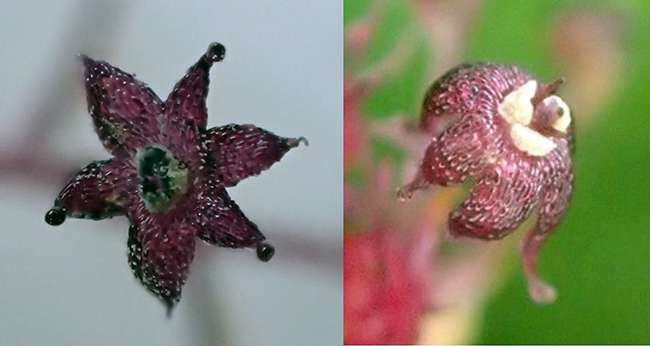Sunlight plants parasitize on mushrooms
A species of flowering plants discovered in Japan spends most of its time hiding underground and stealing fungal nutrients to survive instead of photosynthesis like regular species.
According to New Scientist, in October 2015, Professor Suetsugu Kenji at Kobe University discovered a species not previously recorded when surveying evergreen forest on the subtropical island of Yakushima, Japan. After that, Kenji conducted a detailed examination of the plant's morphological characteristics.

Purple star-shaped flowers of the new parasitic species found on Yakushima island.(Photo: Yamashita Hiroaki).
In the study published in the Japanese Journal of Botany on February 20, the new flowering plant is called Sciaphila yakushimensis , which is named after the place where it was discovered as Yakushima Island. Initially, scientists mistook Sciaphila yakushimensis for another species called Sciaphila japonica. After a thorough analysis, they concluded that they were two completely different species.
Sciaphila yakushimensis has a body length of 3 - 9cm and only appears on the ground when the plant flowers. During the bloom process, the purple star-shaped flowers are pushed up from the ground. Each tree has from 9 to 15 flowers.
This plant does not photosynthesize and take the necessary amount of carbon from parasites that are fungi. Accordingly, the plant will absorb nutrients from the mushroom roots near it and absorb into the trunk of the tree through hairy roots. This is an extremely rare case that scientists call heterotrophic plant symbiosis (mycoheterotrophs).
According to Kenji, Sciaphila yakushimensis evolved in a parasitic way to adapt to the habitat under the forest canopy, where sunlight shines on the ground very little, not enough for plants to carry out photosynthesis. Subterranean development also helps reduce risk of becoming a target of herbivores.
The findings contribute to reaffirming the ecological value of lowland evergreen forest on Yakushima Island. Kenji said he only found two small patches of Sciaphila yakushimensis growing so listed this species as "extremely endangered".
- Detecting night glowing mushrooms in Brazil
- Shiitake mushrooms help improve immune function in humans
- Top 10 most rare mushrooms in Vietnam
- Giant mushrooms appear in mass in Hue
- Identify deadly poisonous mushrooms in Vietnam
- 5 types of mushrooms are not only beautiful as fairy but also delicious and incredible
- Eating mushrooms can prevent cancer but not eat meat or fish
- Photos of beautiful mushrooms in nature
- Discovered the 'eggs' of aliens in rural England
- Colorful beauty of mushrooms
- How to identify and prevent poisonous mushrooms
- The new method transforms sunlight into fuel
 Why do potatoes have eyes?
Why do potatoes have eyes? 'Tragedy' the world's largest carnivorous life: Death becomes ... public toilet
'Tragedy' the world's largest carnivorous life: Death becomes ... public toilet Tomatoes were once considered 'poisonous' for 200 years
Tomatoes were once considered 'poisonous' for 200 years Detecting microscopic parasites on human face
Detecting microscopic parasites on human face